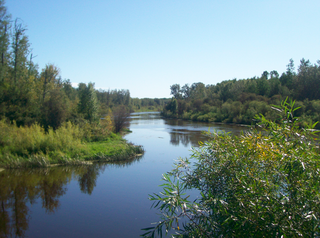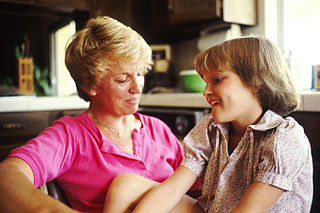
Developmental psychology is the scientific study of how and why humans grow, change, and adapt across the course of their lives. Originally concerned with infants and children, the field has expanded to include adolescence, adult development, aging, and the entire lifespan. Developmental psychologists aim to explain how thinking, feeling, and behaviors change throughout life. This field examines change across three major dimensions, which are physical development, cognitive development, and social emotional development. Within these three dimensions are a broad range of topics including motor skills, executive functions, moral understanding, language acquisition, social change, personality, emotional development, self-concept, and identity formation.

Jealousy generally refers to the thoughts or feelings of insecurity, fear, and concern over a relative lack of possessions or safety.
Personality is any person's collection of interrelated behavioral, cognitive and emotional patterns that comprise a person’s unique adjustment to life. These interrelated patterns are relatively stable, but can change over long time periods.

An attitude "is a summary evaluation of an object of thought. An attitude object can be anything a person discriminates or holds in mind." Attitudes include beliefs (cognition), emotional responses (affect) and behavioral tendencies. In the classical definition an attitude is persistent, while in more contemporary conceptualizations, attitudes may vary depending upon situations, context, or moods.

A relationship breakup, breakup, or break-up is the termination of a relationship. The act is commonly termed "dumping [someone]" in slang when it is initiated by one partner. The term is less likely to be applied to a married couple, where a breakup is typically called a separation or divorce. When a couple engaged to be married breaks up, it is typically called a "broken engagement". People commonly think of breakups in a romantic aspect, however, there are also non-romantic and platonic breakups, and this type of relationship dissolution is usually caused by failure to maintain a friendship.
Environmental psychology is a branch of psychology that explores the relationship between humans and the external world. It examines the way in which the natural environment and our built environments shape us as individuals. Environmental psychology emphasizes how humans change the environment and how the environment changes humans' experiences and behaviors. The field defines the term environment broadly, encompassing natural environments, social settings, built environments, learning environments, and informational environments. According to an article on APA Psychnet, environmental psychology is when a person thinks of a plan, travels to a certain place, and follows through with the plan throughout their behavior.
Emotional dysregulation is a range of emotional responses that do not lie within a desirable scope of emotive response, considering the stimuli.
The term sense of place has been used in many different ways. It is a multidimensional, complex construct used to characterize the relationship between people and spatial settings. It is a characteristic that some geographic places have and some do not, while to others it is a feeling or perception held by people. It is often used in relation to those characteristics that make a place special or unique, as well as to those that foster a sense of authentic human attachment and belonging. Others, such as geographer Yi-Fu Tuan, have pointed to senses of place that are not "positive," such as fear. Some students and educators engage in "place-based education" in order to improve their "sense(s) of place," as well as to use various aspects of place as educational tools in general. The term is used in urban and rural studies in relation to place-making and place-attachment of communities to their environment or homeland. The term sense of place is used to describe how someone perceives and experiences a place or environment. Anthropologists Steven Feld and Keith Basso define sense of place as: 'the experiential and expressive ways places are known, imagined, yearned for, held, remembered, voiced, lived, contested and struggled over […]’. Many indigenous cultures are losing their sense of place because of climate change and "ancestral homeland, land rights and retention of sacred places".
Personality development encompasses the dynamic construction and deconstruction of integrative characteristics that distinguish an individual in terms of interpersonal behavioral traits. Personality development is ever-changing and subject to contextual factors and life-altering experiences. Personality development is also dimensional in description and subjective in nature. That is, personality development can be seen as a continuum varying in degrees of intensity and change. It is subjective in nature because its conceptualization is rooted in social norms of expected behavior, self-expression, and personal growth. The dominant viewpoint in personality psychology indicates that personality emerges early and continues to develop across one's lifespan. Adult personality traits are believed to have a basis in infant temperament, meaning that individual differences in disposition and behavior appear early in life, potentially before language of conscious self-representation develop. The Five Factor Model of personality maps onto the dimensions of childhood temperament. This suggests that individual differences in levels of the corresponding personality traits are present from young ages.
A community of place or place-based community is a community of people who are bound together because of where they reside, work, visit or otherwise spend a continuous portion of their time. Such a community can be a neighborhood, town, coffeehouse, workplace, gathering place, public space or any other geographically specific place that a number of people share, have in common or visit frequently. A community offers many appealing features of a broader social relationship: Safety, familiarity, support and loyalties as well as appreciation. Appreciation that is founded on efforts and contribution to the community, rather than the efforts, rank or status of an individual.
The connectedness to nature scale (CNS) is a measure of individuals' trait levels of feeling emotionally connected to the natural world in the realm of social and environmental psychology. The CNS was “designed to tap an individual’s affective, experiential connection to nature.” The concept of connectedness to nature signifies the relationship between an individual and the environment. In brief, the scale intends to measure the level to which an individual feels connected with the natural world. Mayer and Frantz describe the CNS as a reliable, single-factored, multi-item scale that is easy to administer.

Belongingness is the human emotional need to be an accepted member of a group. Whether it is family, friends, co-workers, a religion, or something else, some people tend to have an 'inherent' desire to belong and be an important part of something greater than themselves. This implies a relationship that is greater than simple acquaintance or familiarity.
Interior design psychology is a field within environmental psychology, which concerns the environmental conditions of the interior. It is a direct study of the relationship between an environment and how that environment affects the behavior of its inhabitants, intending to maximize the positive effects of this relationship. Through interior design psychology, the performance and efficiency of the space and the well-being of the individual are improved. Figures like Walter Benjamin, Sigmund Freud, John B. Calhoun and Jean Baudrillard have shown that by incorporating this psychology into design one can control an environment and to an extent, the relationship and behavior of its inhabitants. An example of this is seen through the rat experiments conducted by Calhoun in which he noted the aggression, killing and changed sexual tendencies amongst rats. This experiment created a stark behavioral analogy between the rat's behavior and inhabitation in high-rise building projects in the US after WWII, an example of which is the Pruitt-Igoe development in St Louis demolished in 1972 only 21 years after being erected.

Nature connectedness is the extent to which individuals include nature as part of their identity. It includes an understanding of nature and everything it is made up of, even the parts that are not pleasing. Characteristics of nature connectedness are similar to those of a personality trait: nature connectedness is stable over time and across various situations.
The theory of narrative identity postulates that individuals form an identity by integrating their life experiences into an internalized, evolving story of the self that provides the individual with a sense of unity and purpose in life. This life narrative integrates one's reconstructed past, perceived present, and imagined future. Furthermore, this narrative is a story – it has characters, episodes, imagery, a setting, plots, and themes and often follows the traditional model of a story, having a beginning, middle, and an end (denouement). Narrative identity is the focus of interdisciplinary research, with deep roots in psychology.

The social sharing of emotions is a phenomenon in the field of psychology that concerns the tendency to recount and share emotional experiences with others. According to this area of research, emotional experiences are not uniquely fleeting and internal. Scientific studies of catastrophes and important life events demonstrate the propensity of victims to talk about their experiences and express their emotions. At the onset of these empirical studies, Rimé et al. coined the term "social sharing of emotions" in 1991 to name the observed phenomenon. This research was a significant development in social psychology because it questioned the accepted view of emotions—that emotions are short-lived and intrapersonal episodes—that was prevalent in the literature. Yet, the first set of experiments revealed that 88–96% of emotional experiences are shared and discussed to some degree. Therefore, the studies concerning the social sharing of emotions contribute a substantial new perspective to the understanding of emotions and their underlying processes.
A functional account of emotions posits that emotions facilitate adaptive responses to environmental challenges. In other words, emotions are systems that respond to environmental input, such as a social or physical challenge, and produce adaptive output, such as a particular behavior. Under such accounts, emotions can manifest in maladaptive feelings and behaviors, but they are largely beneficial insofar as they inform and prepare individuals to respond to environmental challenges, and play a crucial role in structuring social interactions and relationships.
Pro-environmental behaviour is behaviour that a person consciously chooses in order to minimize the negative impact of their actions on the environment. Barriers to pro-environmental behaviour are the numerous factors that hinder individuals when they try to adjust their behaviours toward living more sustainable lifestyles. Generally, these barriers can be separated into larger categories: psychological, social/cultural, financial and structural. Psychological barriers are considered internal, where an individual's knowledge, beliefs and thoughts affect their behaviour. Social and cultural barriers are contextual, where an individual's behaviour is affected by their surroundings. Financial barriers are simply a lack of funds to move toward more sustainable behaviour. Structural barriers are external and often impossible for an individual to control, such as lack of governmental action, or locality of residence that promotes car use as opposed to public transit.
Ecological grief, or in particular climate grief, refers to the sense of loss that arises from experiencing or learning about environmental destruction or climate change. Environmental grief can be defined as "the grief reaction stemming from the environmental loss of ecosystems by natural and man-made events." Another definition is "the grief felt in relation to experienced or anticipated ecological losses, including the loss of species, ecosystems, and meaningful landscapes due to acute or chronic environmental change." For example, scientists witnessing the decline of Australia's Great Barrier Reef report experiences of anxiety, hopelessness, and despair. Groups impacted heavily also include young people feeling betrayal from lack of environmental action by governments and indigenous communities losing their livelihoods.
Interpersonal neurobiology (IPNB) or relational neurobiology is an interdisciplinary framework that was developed in the 1990s by Daniel J. Siegel, who sought to bring together scientific disciplines to demonstrate how the mind, brain, and relationships integrate. IPNB views the mind as a process that regulates the flow of energy and information through its neurocircuitry, which is then shared and regulated between people through engagement, connection, and communication. Drawing on systems theory, Siegel proposed that these processes within interpersonal relationships can shape nervous system maturation. Siegel claimed that the mind has an irreducible quality which informs this approach.








